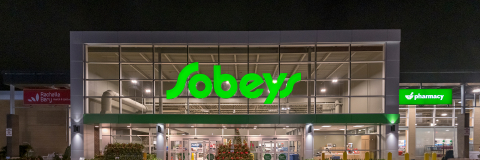Net-zero by 2040 with validated science-based targets*
*for Scope 1 and 2 emissions, and net-zero for Scope 3 emissions by 2050
As climate change has adverse impacts on our planet, including increasing the risk of extreme weather and other potential disruptions, we are taking action to reduce our GHG emissions and to make our business more resilient. We have a bold plan to achieve net-zero by 2040 for our Scope 1 and 2 emissions and net-zero by 2050 for Scope 3 emissions.
Our Approach
Climate change is one of the top priorities in our materiality assessment. Stakeholders have indicated they are interested in the steps we are taking to prepare for, adapt to and mitigate climate-related risks.
Our Climate Action Plan is aimed at meaningfully reducing our direct and indirect greenhouse gas (GHG) emissions and at our transition towards decarbonizing our business and value chain. It demonstrates how doing OurPartR to tackle climate change is a priority for our entire business.
Our plan is built around science-based targets that aim to meet the requirements of the Paris Agreement.
Year 1 of Our Climate Action Plan: Phase 1
We have implemented our Climate Action Plan: Phase 1, which runs from fiscal 2024 to fiscal 2026. Year one of our strategy has focused on taking steps to reduce Scope 1 and 2 emissions from our business by aggressively reducing emissions generated at our stores and warehouses. We have invested approximately $47 million in more than 500 carbon-reduction projects across our grocery stores, including eliminating the vast majority of ozone-depleting refrigerants in our corporate locations, upgrading to high-efficiency HVAC systems, installing artificial intelligence systems to monitor energy performance, and adding solar panels on selected offices. We will continue to aggressively pursue scope 1 emissions reduction drivers in the mechanical rooms of our stores in fiscal 2025. Read more in Energy Management.
Our Targets |
Net-Zero Targets:
|
Near-Term Targets:
|
Setting FLAG Targets for Scope 3
To comply with the SBTi guidance, Empire is required to establish specific targets for GHG emissions related to the forestry, land and agriculture (FLAG) sector. As a company that procures products and services, our FLAG targets must cover at least 67% of FLAG-related Scope 3 emissions. Given this, we are developing FLAG-related targets for Scope 3, Category 1–purchased goods and services. We are collaborating with supplier partners to collect the information required for FLAG emission calculations. As not all our supplier partners are at the same level of maturity on their climate journey, we are taking a thoughtful approach to advance consistency and collaboration.
Empire & Sobeys Inc. Greenhouse Gas Emissions
Emissions summary (tonnes CO2e) 1
| Scope | 2023 | 2022 | 2019 | % difference (2023-2022) |
% difference (2023-2019) |
|---|---|---|---|---|---|
|
Scope 1 |
2023
336,560 |
2022
340,790 |
2019
396,300 |
% difference
(2023-2022) -1.2% |
% difference
(2023-2019) -15.1% |
|
Scope 2 |
2023
215,360 |
2022
232,360 |
2019
357,030 |
% difference
(2023-2022) -7.3% |
% difference
(2023-2019) -39.7% |
|
Scope 3 |
2023
18,281,310 |
2022
17,414,110 |
2019
18,478,700 |
% difference
(2023-2022) 5% |
% difference
(2023-2019) -1.1% |
|
Total Scope 1, 2 |
2023
551,920 |
2022
573,150 |
2019
753,330 |
% difference
(2023-2022) -3.7% |
% difference
(2023-2019) -26.7% |
|
Scope 1 & 2 Intensity (kg CO2e/sq ft) |
2023
23.2 |
2022
23.9 |
2019
32.8 |
% difference
(2023-2022) -3.2% |
% difference
(2023-2019) -29.4% |
CY 2022 Estimated Emissions Breakdown

Note:
-
We use the GHG Protocol to calculate our emissions. 2019-2023 GHG inventory includes all Sobeys Inc. and Empire grocery and related business banners in operation since 2019, including corporate and franchise sites.
-
Scope 1 emissions sources encompass natural gas, propane and fuel oil used for heating and operations in our stores, retail support centres and offices, as well as refrigerant emissions, fuel from corporate and Voilà fleet and diesel in onsite generators.
-
Scope 1 emissions from refrigerant leakage includes our corporate grocery sites where maintenance service providers are integrated with our maintenance-tracking and data-management system. We will be enhancing our data-collection processes over the next year as we continue to work with our service providers to expand coverage of this emissions source.
-
Scope 2 emissions sources encompass electricity consumption.
-
Scope 3 emissions sources encompass purchased goods and services, capital goods, fuel and energy-related activities (not included in Scope 1 or 2), upstream transportation and distribution, waste generated in operations, business travel, employee commuting, down stream transportation and distribution, use of sold products, franchises, and investment.
-
Reported emissions for calendar years 2019, 2020 and 2021 have been recalculated for improved accuracy in accordance with our internal greenhouse gas methodology document and in alignment with guidance from SBTi. Over the past year, we have improved our data collection methodology for mobile combustion emissions and reassessed the data used to calculate Scope 3 Category 1 emissions (purchased goods and services) to remove double counting.
Scope 1, 2 and 3 GHG Emissions Trends and Performance Against Targets
We annually evaluate and improve our methodology for collecting and assessing GHG emissions data, continuously improving our accuracy, transparency and consistency, then evaluating future actions for improvement.
As our emissions summary table shows, we continue to make progress reducing GHG emissions thanks to ongoing investments in energy efficiency and work with our supplier partners. Scope 1 and 2 emissions are almost 27% lower compared to our 2019 base year, primarily thanks to reductions in Scope 2 emissions.
Scope 1 & 2 Emissions
Key Factors Driving Reductions:
- Energy Efficiency: Improved energy consumption in retail locations due to energy efficiency projects and optimization of corporate site areas.
- Fleet Efficiency: Reduced fuel usage in our fleet through better efficiency using strategic fleet planning and management tools.
- Grid Decarbonization: Significant reductions in carbon emissions from electricity use due to cleaner energy sources being added to the electrical grid. For instance, Alberta and Nova Scotia have been incorporating more renewable energy sources including wind and solar, lowering the overall carbon intensity of the electricity we use and contributing to a 4% reduction in Scope 2 emissions.
Key Factors Driving Increase:
- Refrigeration: Overall, emissions rose by 4.5% compared to last year due to increased refrigerant system maintenance and improvement of data systems and tracking in stores leading to better leak detection. However, in retail sites where we have had conversions from high global warming potential (GWP) refrigerants, we have lowered emissions by approximately 3%. As we continue to convert high GWP refrigerants to low GWP refrigerants, we expect to see further reductions in emissions.
- Organic Growth: The expansion of our e-commerce business, Voilà, was particularly associated with the growth of the delivery fleet.
Scope 3 Emissions
Scope 3 emissions increased by 5% from 2022 and decreased by 1.1% compared to our 2019 base year. Purchased goods and services are our biggest drivers of emissions. We are continuously improving the accuracy of the data used to estimate emissions in this category. Our work with supplier partners through the CDP Supply Chain program will lead to a more granular understanding of Scope 3 emissions calculation and reduction opportunities in the coming years.
Key Factors Driving Increase:
- Purchased Goods and Fuel Sold: These categories are the biggest drivers, accounting for most of the growth in our total Scope 3 emissions this year due to organic growth.
Key Factors Driving Decrease:
- Capital Goods: Lower spending on capital goods, such as equipment used in offices, warehouses and stores.
- Transportation: Increased efficiency in our use of third-party transportation.
Climate Action: Reducing Scope 1 & 2 Emissions
During Phase 1 of our plan, from fiscal 2024 to fiscal 2026, we are working to achieve near-term targets by focusing on areas that are most critical to reducing emissions outputs.
| Scope | Target | Status | Key Activities | Way Forward |
|---|---|---|---|---|
|
Scope
1 & 2 |
Target
Annual reduction target (CY year over CY year): 5% Overall reduction from CY 2019 baseline: 25% |
Status
Reduction of 3.7% from CY 2022 Reduction of 27% from CY 2019 Completion of 500+ projects in FY 2024 (year one of our three-year Climate Action Plan) |
Key Activities
Real estate and transportation initiatives:
|
Way Forward
FY 2025 strategy will focus on refrigeration system upgrades and reducing energy consumption and emissions related to refrigerant leaks. As significant carbon footprint is generated from leaks, we can make important advances towards our 2030 climate action goals. Customer-facing initiatives will continue to be reflected in solar projects and EV charging station expansion. We will initiate an RSC energy-efficient program focusing on HVAC upgrades. |
Energy efficiency initiatives reduce GHG emissions and operating costs. Technologies such as LED lights typically have greater efficiencies and longer operational lifespans, requiring fewer repairs and replacements.
Investments in smarter and more agile HVAC systems also reduce energy use by allowing us to customize fan speeds and other requirements on a store-by-store basis, ensuring comfort and operational efficiency.
Implementing artificial intelligence and machine learning (AIML) systems provides real-time, detailed visibility into the operations of refrigeration units in our stores, allowing us to address any issues and optimize for energy-use reductions. In addition to preventing costly repairs, maintenance and equipment downtime, these smart technologies also maintain the best conditions for food quality.
Given that refrigeration leaks are responsible for most of our Scope 1 emissions, we have prioritized investing in low GWP refrigerants, refrigeration retrofits and gas conversions. We are addressing our refrigeration-related emissions in anticipation of impending federally mandated regulations limiting GWP refrigerants.
Understanding our provincial grid intensities, informed by the Canadian Federal Emission Factors and Reference Values, has helped us design our Climate Action Plan to maximize carbon reductions. Provinces such as Saskatchewan, Nova Scotia and Alberta present the greatest opportunities to reduce our GHG emissions due to their reliance on high-emission energy grids. This information informs both the selection of our carbon abatement projects and the type of projects we execute. For example, we are focusing solar projects in areas with higher intensity grids.
To ensure that our projects are both environmentally friendly and offer good business returns, we follow a stringent capital allocation process for our sustainability initiatives. This process is similar to how we manage other capital investments, such as store renovations, and focuses on delivering strong returns. Our fiscal 2024 capital expenditure plans were carefully developed to align with existing store renovation plans, minimizing disruption to customers and teammates.
Each sustainability initiative must pass a rigorous evaluation, ensuring it delivers solid financial returns while reducing GHG emissions in line with our Climate Action Plan. Return on investment (ROI) varies by initiative, with some exceeding our hurdle rate and others falling below it. However, initiatives that fall below our hurdle rate are required to achieve significant GHG emission reductions to be considered. Our ESG Finance team collaborates with various internal teams to track initiative progress and ensure forecasted outcomes are met.
While implementing decarbonization plans incurs additional costs, we adopt measures to mitigate costs impacts such as improving in-store execution and sourcing outcomes. Overall, our approach ensures that our sustainability projects contribute positively to our environmental goals and financial performance.
GHG Emissions Assurance
The mandate of the Audit Committee of our Board of Directors includes reviewing applicable metrics and information contained in our annual Sustainable Business Report. We intend to have a third party provide limited assurance relating to Scope 1 and 2 emissions, including completing an assessment-readiness process. To ensure consistent, accurate and complete data, we have established a robust process, which is applied to all ESG disclosures effective as of fiscal 2022.
Engaging Our Supplier Partners on Climate Action
We’re aiming for a minimum of 64% of suppliers, by spend, to set science-based targets on their Scope 1 and 2 emissions by the end of calendar year 2027. As a first step, we’ve partnered with the CDP Supply Chain program, an organization that manages the global environmental disclosure system, enabling us to provide practical resources to our supplier partners so they can measure and disclose their GHG emissions and set targets. Through the program, we gain insights into:
- Emissions data for each supplier and sector intensity
- Suppliers’ self-assessed climate opportunities and risks
- How our suppliers are engaging with their value chain on sustainability and climate issues
- Emissions target validation (e.g., if they’re science-based) and data verification
To support the launch of CDP Supply Chain, in April 2023 we ran climate action training with all our supplier-facing teams in merchandising and strategic sourcing. Since then, more than two-thirds of requested suppliers have submitted climate data, with 44 suppliers reporting to CDP for the first time in fiscal 2024. We are ahead of our forecasted milestone for the percentage of our suppliers with science-based targets after one year of tracking. More than half of the suppliers that have reported have a science-based target and approximately 25% of suppliers have GHG targets that are not science-based.
In addition to the CDP Supply Chain program, we’ve also focused on training merchandising and strategic sourcing teams in our business to support supplier partners to develop climate action plans.
Partnering to Mitigate and Adapt to Climate Risks
We are focused on building supplier partnerships that address the risks associated with growing and producing food in a changing climate. At the same time, we are expanding our procurement from alternative growing methods such as controlled-environment agriculture (CEAs).
Understanding Climate Risks & Opportunities
We continue to integrate adaptation and mitigation strategies into our daily business operations and future planning. We provide quarterly reports as part of enterprise risk management tracking, which are shared with company leadership and the board. We also continue to meet with key teams across the business to share insights and strategies on adaptation.
Sharing Our Progress
Each year we submit performance data to CDP (formerly the Carbon Disclosure Project) about our climate, forestry and water impacts. In fiscal 2024, CDP upgraded our climate score from C (which indicates we show awareness of climate risks) to B (which recognizes we are managing climate risks). The improved score was thanks in large part to our new Climate Action Plan, including science-based targets, and to our inaugural climate risk assessment and scenario analysis in alignment with TCFD.
Committed to Ongoing Collaboration
Our long-term goal for Scope 3 is net-zero emissions by 2050, which will require decarbonizing our entire supply chain. Our alignment with the CDP Supply Chain program will play an important role in helping us achieve our Scope 3 targets, enabling us to improve scope 3 data measurement and better understand our suppliers’ emissions and progress.
Our second Scope 3 target is to reduce emissions from fuel sold at our filling stations by 28% by 2030. We are continuing to comply with the proposed National Clean Fuel Regulations, which will enable us to achieve an estimated 12% reduction in emissions from fuel sold by 2030. The balance of this emissions reduction work will be achieved through collaborations with our fuel suppliers, including plans to increase the availability of lower carbon-intensity fuel.
The scale and challenge of decarbonizing our business and supply chain are significant and will require transformational change. While our commitment is strong, our Climate Action Plan is dependent on geopolitical, economic, regulatory, supply and other factors beyond the control of our business. We know we cannot achieve our Scope 3 emissions reductions alone. Collaboration, partnership and action from suppliers, industry, government and customers are needed to achieve a more sustainable and low-carbon future. We remain committed to working collaboratively to decarbonize grocery supply chains in Canada and beyond.

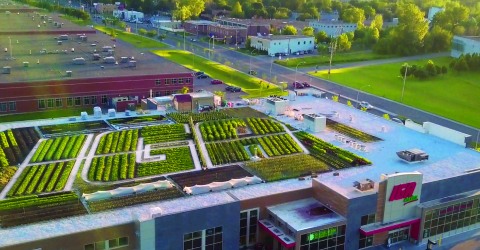
Highlights
Showcasing Climate Action Plan Improvements
- Installing interior and exterior LED lighting
- Converting refrigeration units to a new C02 system using natural refrigerants with low global warming potential
- Installing glass doors on cases and bunkers and roll-down curtains at night in the produce section to reduce the energy needed to maintain temperatures while keeping products fresher for longer
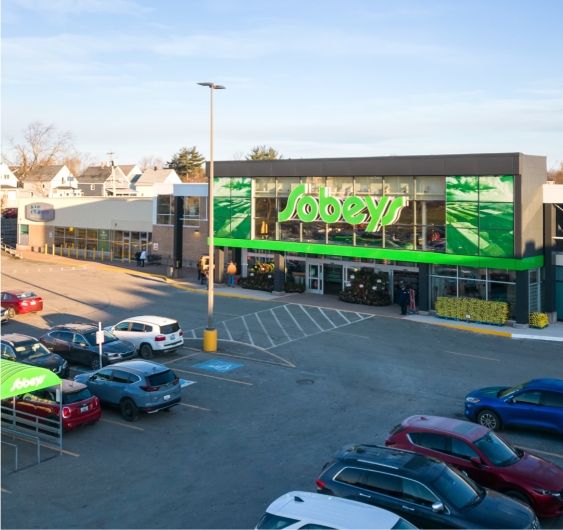
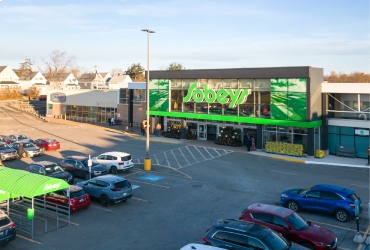
Expanding Use of Rooftop Solar
Our Longo’s team is committed to working with building partners to ensure that all new stores and major renovations incorporate efficient technologies and features to ensure sustainable operations. To date, Longo’s has installed solar panels at eight stores and at the team’s support centre, turning underutilized rooftops into clean energy-generating stations. In 2023, Longo’s generated 1,798,792kWh of solar energy—enough energy to power 140 homes for a year.
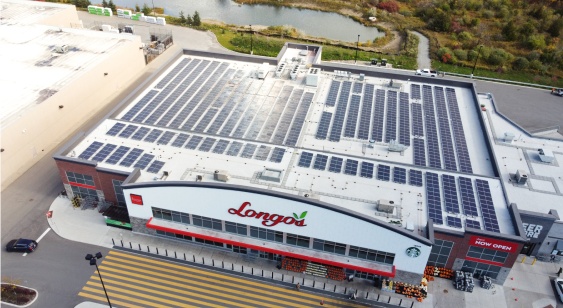
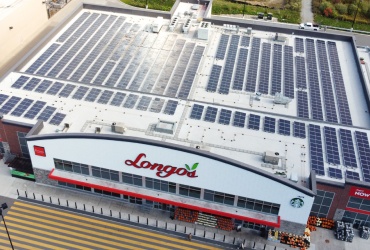
Champions
We are all extremely proud of our newly renovated store [in the Aberdeen Mall, New Glasgow, NS], right here in our hometown. We are proud to be leaning into our sustainability strategy, which will have real and meaningful positive impacts.”
Dave Sobey, VP Atlantic Operations



Learn More
Our work to tackle climate change includes our focus on energy management and environmental management.
As a family nurturing families, we want to ensure Canadians are taken care of today, tomorrow and in the future. By doing OurPartR for the environment, we hope to inspire our customers to do theirs. Every step we take together—big or small—can make a difference.
Learn More
